
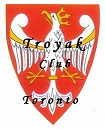
TROYAK EXECUTIVE TEAM is informing all members, colleagues, collectors, and Polonia at large, that Club meetings taking place at John Paul II Polish Cultural Centre, 4300 Cawthra Rd. (just south of Hwy. 403), Mississauga, Ontario. The new members are always welcome. www.polishculturalcentre.ca
ADRES SPOTKAÑ KLUBOWYCH ! Zarząd Główny Klubu “Troyak” informuje wszystkich członków kolekcjonerów, sympatyków oraz całą Polonię, że spotkania klubowe odbywają się w Polskim Centrum Kultury im. Jana Pawła II, przy 4300 Cawthra Rd. (na południe od autostrady 403), Mississauga, Ontario. Zapraszamy nowych członków do prężnego. Klubu “Troyak”. www.polishculturalcentre.ca

“TROYAK” CLUB NEXT MEETINGS …
NASTĘPNE SPOTKANIA KLUBU “TROYAK” …
Sunday 27th October 2024 @ 4:30 p.m.
24th November 2024

Sunday – 1st December 2024 @ 9:00 a.m. to 4:00 p.m.
Mississauga Coin & Stamp Show

December 2024 … Happy Holidays!

Sunday 12th January 2025 AGM
Sunday 26th January 2025
Sunday 23rd February 2025
Sunday – 2nd March 2025 @ 9:00 a.m. to 4:00 p.m.
Mississauga Coin & Stamp Show
Sunday 30th March 2025
Sunday 27th April 2025
Sunday 25th May 2025
Sunday 22nd June 2025

July 2025 & August 2025 –
Summer break … Letnie wakacje …


Polskie transatlantyki
Polish transatlantic ships
www.poczta-polska.pl
30.07.2024 … Na znaczkach przedstawiono wizerunki statków z obrazów Adama Werki: ***na pierwszym – transatlantyk m/s Chrobry; ***na drugim – transatlantyk s/s Jagiełło; ***na trzecim – transatlantyk ts/s Stefan Batory. Nominał znaczka: 4,90 zł … Ilość znaczków w emisji:3; Ilość znaczków w arkuszu: 6; Format znaczka: 76,5 x 31,25 mm; Papier: Fluorescencyjny; Nakład: 120 000 szt.; Technika druku: Offset; Format koperty FDC: 215×108; Autor projektu: Poczta Polska S.A.
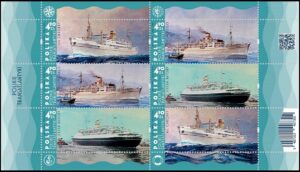
30.07.2024 … The stamps show images of ships from Adam Verka’s paintings: ***1. on the first one – transatlantic m/s Chrobry; ***2. on the second – transatlantic s/s Jagiello; ***3. on the third – transatlantic ts/s Stefan Batory. Denomination: 4,90 PLN … Number of stamps in issue: 3; Number of stamps in sheet: 6; Stamp size: 76,5 x 31,25 mm; Paper: Fluorescent; Printing techniques: Offset; Print run: 120 000 pcs.; FDC size: 215×108 mm. Designer: Poczta Polska S.A.
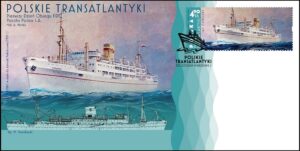
Koperta FDC emisji “Polskie transatlantyki – m/s Chrobry” … Data emisji: 30.07.2024 … Na znaczkach przedstawiono wizerunki statków z obrazów Adama Werki: transatlantyk m/s Chrobry.
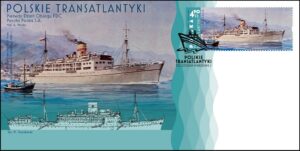
Koperta FDC emisji “Polskie transatlantyki – s/s Jagiełło” … Data emisji: 30.27.2024 … Na znaczkach przedstawiono wizerunki statków z obrazów Adama Werki: transatlantyk s/s Jagiełło.
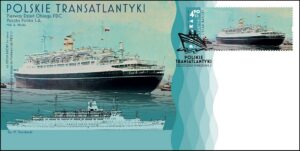
Koperta FDC emisji “Polskie transatlantyki – ts/s Stefan Batory” … Data emisji: 30.07.2027 … Na znaczkach przedstawiono wizerunki statków z obrazów Adama Werki: transatlantyk ts/s Stefan Batory.

30 lat Agencji Restrukturyzacji i Modernizacji Rolnictwa
30 years of the Agency for Restructuring
and Modernization of Agriculture
www.poczta-polska.pl
31.07.2024 … W prawym górnym rogu strony adresowej kartki nadrukowano znak opłaty pocztowej, na którym umieszczono fotografię dłoni rolnika doglądającego plony; w lewym górnym rogu umieszczono oznaczenie wartości: A; w prawym dolnym rogu – logo Agencji Restrukturyzacji i Modernizacji Rolnictwa, a wzdłuż lewej krawędzi – napis: POLSKA.
W części ilustracyjnej kartki umieszczono nazwę emisji: “30 lat Agencji Restrukturyzacji i Modernizacji Rolnictwa”, napis: „od 1994 wspieramy polskich rolników” oraz kolaż zdjęć obrazujących przykładowe obszary wsparcia finansowego udzielanego na rzecz rozwoju sektora rolno-spożywczego przez Agencję Restrukturyzacji i Modernizacji Rolnictwa. W datowniku – grafika z logotypu ARiMR. Emisja powstała we współpracy z wnioskodawcą – Agencją Restrukturyzacji i Modernizacji Rolnictwa. Nominał znaczka: A … Autor projektu: Poczta Polska S.A.; Format całostki: 148x105mm; Nakład: 5 000 szt.; Technika druku: Offset; Data emisji: 31.07.2024.

30 years of the Agency for Restructuring and Modernization of Agriculture … In the upper right corner of the address side of the card there is a printed postage stamp with a photograph of the hand of a farmer tending to his crops; in the upper left corner there is a value designation: A; in the lower right corner – the logo of the Agency for Restructuring and Modernisation of Agriculture, and along the left edge – the inscription: POLSKA.
The illustrative part of the card includes the name of the issue: “30 years of the Agency for Restructuring and Modernisation of Agriculture”, the inscription: “we have been supporting Polish farmers since 1994” and a collage of photos illustrating example areas of financial support provided for the development of the agri-food sector by the Agency for Restructuring and Modernisation of Agriculture. In the date stamp – a graphic of the ARiMR logo. The issue was created in cooperation with the applicant – the Agency for Restructuring and Modernisation of Agriculture. Stamp denomination: AND; Designer: Polish Post SA; Format of the whole: 148x105mm; Circulation: 5,000 pcs.; Printing technique: Offset; Data of issue: 31.07.2024.

80. rocznica Powstania Warszawskiego
80th Anniversary of the Warsaw Uprising
www.pocztaa-polska.pl
01.08.2024 … Na znaczku przedstawiono zdjęcie powstańców na stanowisku strzeleckim w zrujnowanym wejściu do kościoła Świętego Krzyża przy Krakowskim Przedmieściu w Warszawie.

Nominał znaczka … 10,00 zł … Format bloku: 121 x 63 mm; Format znaczka: 39,5 x 51 mm; Ilość znaczków w bloku: 1; Ilość znaczków w emisji: 1; Nakład: 90 000 szt.; Papier: Fluorescencyjny; Technika druku: Offset; Format koperty FDC: 207×149; Koperta FDC emisji “80.rocznica Powstania Warszawskiego” Nominał znaczka: 10,00 zł; Nakład: 90 000 szt.; Autor projektu: Roch Stefaniak.

80th Anniversary of the Warsaw Uprising … 01 August 2024 … Denomination: 10,00 PLN; Number of stamps in block: 1; Number of stamps in issue: 1; Stamp size: 39,5 x 51 mm; Block size: 121 x 63 mm; Paper: Fluorescent; Printing techniques: Offset; Print run: 90 000 pcs; FDC size: 207×149; Designer: Roch Stefaniak.

XVII Letnie Igrzyska Paralimpijskie Paryż 2024
XVII Paralympic Summer Games Paris 2024
www.poczta-polska.pl
09.08.2024 … Na znaczku przedstawiono elementy graficzne nawiązujące do Paryża i Igrzysk Paralimpijskich: widok Wieży Eiffla, Łuku Triumfalnego i znicza olimpijskiego. Ponadto wzdłuż górnej krawędzi znaczka zmieszczono piktogram symbolizujący biegacza paralimpijskiego oraz logotyp Polskiego Komitetu Paralimpijskiego.

Nominał znaczka: 4,90 zł … Autor projektu: Paweł Myszka; Format znaczka: 31,25 x 43 mm; Ilość znaczków w emisji: 1; Ilość znaczków w arkuszu: 9; Nakład: 126 000 szt.; Papier: Fluorescencyjny: Technika druku: Offset; Koperta FDC emisji “XVII Letnie Igrzyska Paralimpijskie Paryż 2024” : 1; .Data emisji: 09.08.2024.

XVII Paralympic Summer Games Paris 2024 … The stamp depicts graphic elements referring to Paris and the Paralympic Games: a view of the Eiffel Tower, the Arc de Triomphe and the Olympic torch. In addition, a pictogram symbolizing a Paralympic runner and the logo of the Polish Paralympic Committee have been fitted along the upper edge of the stamp. Denomination: 4,90 PLN; Designer: Paweł Myszka; Number of stamps in issue: 1; Number of stamps in sheet: 9; Stamp size: 31,25 x 43 mm; Paper: Fluorescent; Print run: 126 000 pcs; Printing techniques: Offset; Date of issue: 09.08.2024.

Polski design
Polish design
www.poczta-polska.pl
30.08.2024 … Na znaczkach przedstawiono: ***na pierwszym – zdjęcie fotela “Tulipan” autorstwa Teresy Kruszewskiej, wzdłuż górnej krawędzi znaczka umieszczono napis: POLSKA i oznaczenie wartości: 4,90 zł.; ***na drugim – zdjęcie stołka PLOPP autorstwa Oskara Zięty, wzdłuż górnej krawędzi znaczka umieszczono napis: POLSKA i oznaczenie wartości: 4,90 zł.

Nominał znaczka: 4,90 zł; Autor projektu: Agnieszka Sancewicz; Format znaczka: 40,5 x 40,5 mm; Ilość znaczków w arkuszu: 4; Nakład: 100 000 szt.; Papier: Fluorescencyjny; Technika druku: Offset + raster stochastyczny.

Polish design … The stamps show: ***on the first one – a photo of the armchair “Tulip” by Teresa Kruszewska, along the upper edge of the stamp there is an inscription: POLAND and the value designation: PLN 4.90; ***on the second one – a photo of the PLOPP stool by Oskar Zięta, along the upper edge of the stamp there is an inscription: POLAND and the value designation: PLN 4.90. Denomination: 4,90 PLN; Designer: Agnieszka Sancewicz; Number of stamps in sheet: 4; Paper: Fluorescent; Printing techniques: Offset + stochastic raster; Print run: 100 000 pcs. Date of issue: 30.08.2024.

160. rocznica śmierci Romualda Traugutta
www.nbp.pl
Narodowy Bank Polski jest centralnym bankiem państwa odpowiadającym za politykę pieniężną i stabilność cen. Jego funkcje określa Konstytucja Rzeczypospolitej Polskiej i ustawa o NBP. NBP ma wyłączne prawo emisji pieniądza. Jako bank centralny nie prowadzi rachunków bankowych obywateli, nie przyjmuje od nich lokat, nie udziela kredytów. Prowadzi natomiast obsługę budżetu państwa, a także podmiotów sektora finansów publicznych. Gromadzi rezerwy walutowe państwa i zarządza nimi. Pełni funkcję banku banków, tworząc warunki do działania systemu bankowego. Jest również jednym z najważniejszych ośrodków naukowo-analitycznych w dziedzinie ekonomii i rynków finansowych. Emisja wartości kolekcjonerskich stanowi okazję do upamiętniania ważnych historycznych rocznic i postaci oraz do rozwijania zainteresowań polską kulturą, nauką i tradycją. 23 lipca 2024 roku Narodowy Bank Polski wprowadził do obiegu złotą monetę o nominale 200 zł oraz srebrną monetę o nominale 10 zł „160. rocznica śmierci Romualda Traugutta”.
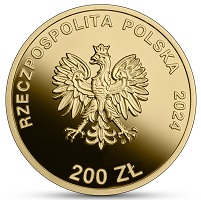
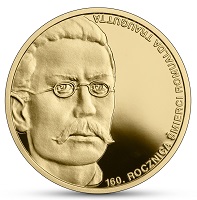
Nominał: 200 zł … metal: Au 900/1000; stempel: lustrzany; średnica: 27,00 mm; masa: 15,50 g; brzeg (bok): gładki; nakład: do 1200 szt. Rewers monety złotej przedstawia wizerunek Romualda Traugutta. Na awersie widnieją stałe elementy: nominał, wizerunek orła ustalony dla godła Rzeczypospolitej Polskiej oraz rok emisji.
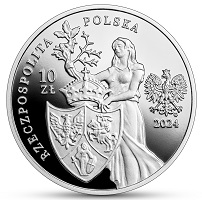
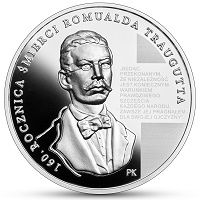
Nominał: 10 zł … metal: Ag 999/1000; stempel: lustrzany, wysoki relief; średnica: 32,00 mm; masa: 31,10 g; brzeg (bok): gładki; nakład: do 10 000 szt.; Projektantka monety złotej: Dobrochna Surajewska; Projektantka monety srebrnej: Paulina Kotowicz; Emitent: NBP; Na zlecenie NBP monety wyprodukowała Mennica Polska SA.
Na rewersie monety srebrnej umieszczono wizerunek Romualda Traugutta oraz jego słowa wypowiedziane podczas śledztwa prowadzonego przez Rosjan. Na awersie monety srebrnej jako alegoria wolności została zaprezentowana postać kobiety trzymającej w dłoni gałązki z liśćmi dębu i głogu z cierniami – symbole siły, wytrwałości i cierpienia. Obok jej wizerunku znajduje się herb Polski, Litwy i Rusi z powstania styczniowego.
Romuald Traugutt (1826–1864) jest jednym z najbardziej rozpoznawalnych bohaterów powstania styczniowego, symbolem walki do samego końca, szlachetności i męczeństwa. Trzydzieści sześć pierwszych lat życia Traugutta nie zapowiadało jego niezwykłej historii. Przyszły przywódca insurekcji pochodził z niezamożnej rodziny szlacheckiej osiadłej na Grodzieńszczyźnie. Po ukończeniu gimnazjum w Świsłoczy zamierzał zostać inżynierem, a gdy okazało się to niemożliwe, wstąpił do carskiej armii. W jej szeregach wziął udział w interwencji przeciwko powstaniu węgierskiemu oraz w wojnie krymskiej. Przeżycia osobiste i postępująca wada wzroku wpłynęły na decyzję o porzuceniu służby w carskim wojsku i osiedleniu się pod Kobryniem. Wobec wybuchłego w styczniu 1863 r. powstania były podpułkownik carskiej armii zachował początkowo duży dystans. Nie bez obaw, namówiony przez sąsiadów, stanął na czele oddziału powstańczego.
„Jako Polak osądziłem: za mą powinność nieoszczędzania siebie tam, gdzie inni wszystko poświęcali” – wyjaśniał później swoją decyzję. Bił się dzielnie i z pewnymi sukcesami, ale wobec przewagi wroga i po wyczerpaniu możliwości walki rozwiązał oddział, a sam, chory i wycieńczony, ukrył się u pisarki Elizy Orzeszkowej. Następnie wyjechał do Warszawy, a potem pod przybranym nazwiskiem Michał Czarnecki udał się z misją do Francji. 17 października 1863 r. Traugutt został przywódcą insurekcji. W odróżnieniu od dwóch poprzednich dyktatorów – Ludwika Mierosławskiego i Mariana Langiewicza – kierował walką w ścisłej tajemnicy, bezpośrednio kontaktował się zaledwie z kilkoma osobami. Całą energię koncentrował na sprawach finansowych, odbudowie powstańczej siły zbrojnej i staraniach o pomoc ze strony państw zachodnioeuropejskich. Pomimo poświęcenia i desperackiej walki powstanie nie miało szans na zwycięstwo. Traugutt jednak do końca trwał na posterunku. Został aresztowany przez Rosjan w swojej konspiracyjnej siedzibie, w warszawskim mieszkaniu przy ulicy Smolnej 3. Nie stawiał oporu, wypowiedział jedynie słowa: „To już…”.
Został osadzony w X Pawilonie Cytadeli Warszawskiej i mimo brutalnego śledztwa nie wydał nikogo. Powieszono go 5 sierpnia 1864 r. wraz z czterema członkami Rządu Narodowego. Egzekucji przyglądało się 30 tys. ludzi. Tłum, klęcząc, śpiewał suplikację: „Święty Boże, święty mocny”. Niezłomna postawa i męczeńska śmierć dały początek legendzie ostatniego dyktatora powstania styczniowego. Za ideowego spadkobiercę Traugutta uważał się inny więzień Cytadeli Warszawskiej – Józef Piłsudski. Informacja: Wojciech Kalwat.

160th Anniversary of the Death of Romuald Traugutt
www.nbp.pl
Narodowy Bank Polski is the central bank of the State, responsible for its monetary policy and price stability. The Bank’s functions are described in the Constitution of the Republic of Poland and the Act on NBP. NBP holds the exclusive right to issue the currency of the Republic of Poland. As the central bank, it does not provide accounts for the general public, accept deposits from or extend loans to individuals. It acts as a banker to the State budget and public sector entities. NBP also holds and manages the foreign exchange reserves of the State. Finally, it functions as a banker to banks, creating conditions for the operation of the Polish banking system. Narodowy Bank Polski is one of the most important research and analytical centres in the fields of economics and financial markets.
Issuing collector items is an occasion to commemorate important historic figures and anniversaries, as well as to develop the interest of the public in Polish culture, science and tradition. On 23 July 2024, Narodowy Bank Polski issued into circulation a gold coin with a face value of 200 złoty and a silver coin with a face value of 10 złoty – “160th Anniversary of the Death of Romuald Traugutt”.


Face value: 200 zł … Metal: Au 900/1000; Finish: proof; Diameter: 27.00 mm; Weight: 15.50 g; Edge (side): plain; Mintage: up to 1,200 pcs; Designer: Dobrochna Surajewska. The reverse of the gold coin depicts the image of Romuald Traugutt. The obverse bears the regular elements: the face value, the image of the Eagle established as the state emblem of the Republic of Poland and the year of issue.


Face value: 10 zł … Metal: Ag 999/1000; Finish: proof, high relief; Diameter: 32.00 mm; Weight: 31.10 g; Edge (side): plain; Mintage: up to 10,000 pcs; Designer: Paulina Kotowicz; Issuer: Narodowy Bank Polski; The coins, commissioned by Narodowy Bank Polski, were struck by Mennica Polska SA.
The reverse of the silver coin features an image of Romuald Traugutt and his words spoken during the investigation by the Russians at the Warsaw Citadel. On the obverse of the silver coin, a figure of a woman holding twigs with oak leaves and hawthorn stems with thorns – symbols of strength, perseverance and suffering – is presented as an allegory of freedom. Next to her image there is the coat of arms of Poland, Lithuania and Ruthenia from the January Uprising.
Romuald Traugutt (1826-1864) is one of the most recognisable heroes of the January Uprising, a symbol of struggle to the very end, of nobility and martyrdom. The first thirty-six years of Traugutt’s life did not foreshadow his extraordinary story. The future leader of the insurrection came from a family of landed gentry of modest means settled in the Grodno region. After completing gymnasium in Świsłocz, he intended to become an engineer, but when this proved impossible, he joined the Tsarist army. In its ranks, he took part in the intervention against the Hungarian uprising and in the Crimean War. Personal experiences and progressive visual impairment influenced his decision to leave the Tsarist army and settle near Kobryń. The former lieutenant-colonel of the Tsarist army initially kept his distance from the uprising that broke out in January 1863. Not without misgivings, persuaded by his neighbours, he stood at the head of an insurgent unit. “As a Pole, I judged that it was my duty not to save myself where others sacrificed everything,” he later explained his decision.
He fought bravely and with some success, but in view of the enemy’s superiority and having exhausted the possibilities of combat, he disbanded the unit, and himself, sick and exhausted, hid at the writer Eliza Orzeszkowa’s place. He then left for Warsaw, and later, under the assumed name of Michał Czarnecki, he went on a mission to France. On 17 October 1863, Traugutt became the leader of the insurrection. Unlike the two previous dictators, Ludwik Mieroslawski and Marian Langiewicz, he headed the struggle in strict secrecy, directly contacting only a few individuals. He concentrated all his energy on financial matters, rebuilding the insurgent armed force and seeking help from Western European countries. Despite dedication and desperate struggle, the uprising had no chance of victory. Traugutt, however, remained steadfast until the end.
He was arrested by the Russians at his conspiratorial headquarters, in his Warsaw flat at 3 Smolna Street. He offered no resistance and only uttered the words: “So there it is …”. He was imprisoned in the 10th Pavilion of the Warsaw Citadel and, despite a brutal interrogation, did not denounce anyone. He was hanged on 5 August 1864, together with four members of the National Government. The execution was watched by 30,000 people. The crowd, kneeling, sang the supplication: ‘Holy God, Holy Mighty One’. Traugutt’s indomitable attitude and martyrdom gave birth to the legend of the last dictator of the January Uprising. Another prisoner of the Warsaw Citadel, Józef Piłsudski, considered himself Traugutt’s ideological heir. Info: Wojciech Kalwat.

Historia monety polskiej –
Grosz z miedzi krajowej Stanisława Augusta
www.nbp.pl
Narodowy Bank Polski jest centralnym bankiem państwa odpowiadającym za politykę pieniężną i stabilność cen. Jego funkcje określa Konstytucja Rzeczypospolitej Polskiej i ustawa o NBP. NBP ma wyłączne prawo emisji pieniądza. Jako bank centralny nie prowadzi rachunków bankowych obywateli, nie przyjmuje od nich lokat, nie udziela kredytów. Prowadzi natomiast obsługę budżetu państwa, a także podmiotów sektora finansów publicznych. Gromadzi rezerwy walutowe państwa i zarządza nimi. Pełni funkcję banku banków, tworząc warunki do działania systemu bankowego. Jest również jednym z najważniejszych ośrodków naukowo-analitycznych w dziedzinie ekonomii i rynków finansowych.
Emisja wartości kolekcjonerskich stanowi okazję do upamiętniania ważnych historycznych rocznic i postaci oraz do rozwijania zainteresowań polską kulturą, nauką i tradycją. 7 sierpnia 2024 roku Narodowy Bank Polski wprowadził do obiegu srebrną monetę o nominale 20 zł „Historia monety polskiej” – „Grosz z miedzi krajowej Stanisława Augusta”.
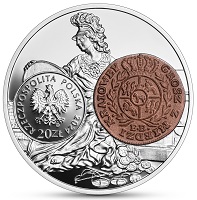
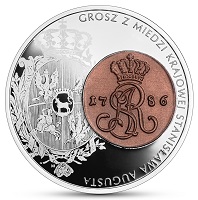
Nominał: 20 zł … metal: Ag 925/1000; stempel: lustrzany, selektywne platerowanie; średnica: 38,61 mm; masa: 28,28 g; brzeg (bok): gładki; nakład: do 10 000 szt.; Projektantka: Dominika Karpińska-Kopiec; Emitent: NBP; Na zlecenie NBP monety wyprodukowała Mennica Polska SA.
Na awersie nowej monety kolekcjonerskiej umieszczono obok siebie dwa okręgi: z lewej strony z wizerunkiem orła ustalonym dla godła Rzeczypospolitej Polskiej, napisem RZECZPOSPOLITA POLSKA, rokiem emisji: 2024 oraz nominałem 20 ZŁ. W okręgu z prawej strony natomiast został odwzorowany rewers opisanej wyżej monety Stanisława Augusta z tarczą pięciopolową. Jako tło wykorzystano piękny medal Jana Filipa Holzhäussera z przedstawieniem Junony Monety, wybity w 1766/1767 r. dla upamiętnienia reformy monetarnej i otwarcia nowej mennicy w Warszawie. Na rewersie nowej monety głównym elementem jest awers monety Stanisława Augusta z jego monogramem i datą 1786. Tłem, usytuowanym z lewej strony, jest superekslibris króla z pięciopolową tarczą herbową. Stanowi ona pełną analogię do tarczy z monety o nominale 1 grosz. Całość dopełnia napis w otoku: GROSZ Z MIEDZI KRAJOWEJ STANISŁAWA AUGUSTA.
Chaos monetarny, jaki pozostał po czasach saskich, Stanisław August opanował już na początku swojego panowania (1764–1795). Król nie tylko prowadził skuteczną politykę pieniężną, lecz także osobiście dbał o jakość i wygląd monet. Co więcej, kiedy na początku mennica przynosiła straty, pokrywał deficyt z własnej szkatuły. Nowy system monetarny został wprowadzony w 1766 r. na mocy uniwersału Komisji Skarbowej. Bito dukaty, talary i ich frakcje oraz najpowszechniejsze monety miedziane: trojaki, grosze, półgrosze i szelągi.
Niektóre z nich nosiły napis również w języku polskim, który informował o nazwie monety i pochodzeniu krajowego kruszcu wydobywanego wówczas w podkieleckich kopalniach. Monety bito najpierw w Krakowie, a potem już tylko w nowo otwartej mennicy warszawskiej. Z niej pochodzi moneta miedziana o nominale 1 grosz. Na stronie głównej, czyli na awersie, pod koroną został umieszczony monogram królewski złożony z liter SAR (Stanislaus Augustus Rex). Rozdziela on datę wybicia: 17 – 86. Na stronie odwrotnej, czyli na rewersie, pod koroną przedstawiono pięciopolową tarczę z herbami Polski i Litwy oraz herbem Ciołek Poniatowskich w środku. U dołu widać litery E.B. oznaczające warszawskiego mincerza Efraima Brenna, a w otoku napis: GROSZ Z MIEDZI KRAIOWEY. Informacja: Stanisław Suchodolski.

History of Polish Coin –
The Domestic Copper Grosz of King Stanisław August
www.nbp.pl
Narodowy Bank Polski is the central bank of the State, responsible for its monetary policy and price stability. The Bank’s functions are described in the Constitution of the Republic of Poland and the Act on NBP. NBP holds the exclusive right to issue the currency of the Republic of Poland. As the central bank, it does not provide accounts for the general public, accept deposits from or extend loans to individuals. It acts as a banker to the State budget and public sector entities. NBP also holds and manages the foreign exchange reserves of the State. Finally, it functions as a banker to banks, creating conditions for the operation of the Polish banking system. Narodowy Bank Polski is one of the most important research and analytical centres in the fields of economics and financial markets.
Issuing collector items is an occasion to commemorate important historic figures and anniversaries, as well as to develop the interest of the public in Polish culture, science and tradition. On 7 August 2024, Narodowy Bank Polski issued into circulation a silver coin of the series “History of Polish Coin” – “The Domestic Copper Grosz of King Stanisław August”, with a face value of 20 złoty.


Face value: 20 zł … Metal: Ag 925/1000; Finish: proof, selective planting; Diameter: 38.61 mm; Weight: 28.28 g; Edge (side): plain; Mintage: up to 10,000 pcs; Designer: Dominika Karpińska-Kopiec; Issuer: Narodowy Bank Polski; The coins, commissioned by Narodowy Bank Polski, were struck by Mennica Polska SA.
The obverse of the new collector coin features two circles positioned side by side. The circle on the left contains the image of the Eagle established as the state emblem of the Republic of Poland, the inscription RZECZPOSPOLITA POLSKA (Republic of Poland), the year of issue: 2024 and the face value of 20 ZŁ. The circle on the right, on the other hand, reproduces the reverse of the coin of Stanisław August with the five-field escutcheon. The beautiful medal by Jan Filip Holzhäusser with a representation of Juno Moneta, struck in 1766/1767 to commemorate the monetary reform and the opening of the new mint in Warsaw, was used as the background.
The main element of the reverse of the new coin is the obverse of the coin of Stanisław August with his monogram and the date 1786. In the background, situated on the left, there is the king’s supralibros with a five-field escutcheon. It is a complete analogy of the escutcheon from the 1 grosz coin. The whole is completed with an inscription along the rim: GROSZ Z MIEDZI KRAJOWEJ STANISŁAWA AUGUSTA (The Domestic Copper Grosz of King Stanisław August).
The monetary chaos that remained after the reign of the Saxon Wettin dynasty in Poland was brought under control by King Stanisław August at the very beginning of his reign (1764-1795). The king not only pursued an effective monetary policy, but also personally took care of the quality and appearance of the coins. What is more, when the mint initially ran at a loss, he covered the deficit from his own coffers. A new monetary system was introduced in 1766 by a universal decree of the Crown Treasury Commission. Ducats, thalers and their fractions were minted, as well as the most common copper coins: the trojak, the grosz, the half-grosz and the schilling. Some of them also bore an inscription in Polish, which provided information about the name of the coin and the origin of the domestic ore, extracted in the mines near Kielce at that time.
Coins were initially struck in Krakow and later only at the newly established mint in Warsaw. It is that mint that the copper coin with a face value of one grosz comes from. The front face, i.e. the obverse, bears the royal monogram composed of the letters SAR (Stanislaus Augustus Rex) under the crown. It separates the date of issue: 17 – 86. On the back face, or the reverse, under the crown is a five-field escutcheon with the state emblems of Poland and Lithuania and the Ciołek coat of arms of the Poniatowski family in the centre. At the bottom, there are the letters E.B. representing the Warsaw minter Efraim Brenna, and along the rim, the inscription: GROSZ Z MIEDZI KRAIOWEY (The Domestic Copper Grosz). Info: Stanisław Suchodolski.


2024 Indigenous Leaders –
Christi Belcourt booklet of 6 Permanent™
www.canadapost.ca
Each booklet includes six Permanent™ stamps featuring Métis visual artist and environmentalist Christi Belcourt. The stamp is one of three in the 2024 Indigenous Leaders issue, the third set of stamps in the Indigenous Leaders series.
Good to know … The Indigenous Leaders series recognizes the outstanding achievements and contributions of First Nations, Inuit and Métis leaders. The 2024 issue pays tribute to three remarkable women: ***Christi Belcourt, Métis visual artist and environmentalist.***Elisapie, award-winning singer-songwriter, actor, director, producer and activist. ***Josephine Mandamin, Anishinaabe Elder and world-renowned water-rights activist.
About the Indigenous Leaders series … The Indigenous Leaders series, launched in 2022, highlights the contributions of modern-day First Nations, Inuit and Métis leaders who dedicated their lives to preserving their culture and improving the quality of life of Indigenous Peoples in Canada.

About Christi Belcourt … Christi Belcourt (b. 1966) is a Métis visual artist and environmentalist who uses her talent to celebrate nature, honour her ancestors, advocate for the protection of land and water, and support Indigenous knowledge, culture and language. A descendant of the Métis community of Manitow Sâkahikan (Lac Ste. Anne) in Alberta, she is well known for her intricate paintings that emulate Métis floral beadwork. Her work can be found in many private and public collections, including the National Gallery of Canada, the Art Gallery of Ontario and the Gabriel Dumont Institute.
The power of Belcourt’s art lies in both its beauty and its message. One of her most poignant works is Walking With Our Sisters, a multi-artist installation of more than 2,000 pairs of beaded moccasin tops honouring the lives of missing or murdered Indigenous women, Two-Spirit people and children. As co-founders of the community-based Onaman Collective, she and Isaac Murdoch volunteer their time to create resources and space for land-based Indigenous practices, including language revitalization. Belcourt’s many honours include a Governor General’s Innovation Award, for advocating for the rights of Indigenous Peoples and recognition of their lands.
About the design … The booklet cover features detail from Christi Belcourt’s painting Reverence for Life. The inside of the booklet includes six stamps, a quote from Belcourt, and a large-format sticker featuring her painting Joy. It also features a light, monotone blue version of detail from Reverence for Life. The back features a short text on Christi Belcourt, a bar barcode and credits. Cancellation Site: Ottawa, Ontario; Stamp Designer: Andrew Perro; Stamp Illustrator: Christi Belcourt; Product Type: Stamps; Quantity Produced: 600,000; Issue Date: June 21, 2024.

Indigenous Leaders – Christi Belcourt: Official First Day Cover … The Official First Day Cover features a stamp honouring Métis visual artist and environmentalist Christi Belcourt. The stamp is one of three in the 2024 Indigenous Leaders issue, the third set of stamps in the Indigenous Leaders series. It is cancelled in Ottawa, Ontario, where Belcourt was raised.
The front of the Official First Cay Cover features detail from Belcourt’s painting Reverence for Life. The front also includes the text “Christi Belcourt” and the Christi Belcourt stamp, cancelled in Ottawa, Ontario – where Belcourt was raised. The back of the OFDC is a continuation of the design detail from the front of the envelope, shown in light, monotone blue. The stamp was cancelled on June 21, which is National Indigenous Peoples Day. The cancel mark is a line drawing of a butterfly, inspired by Belcourt’s style of painting. Stamp Designer: Andrew Perro; Stamp Illustrator: Christi Belcourt; Issue Date: June 21, 2024; Quantity Produced: 6,000.

2024 Indigenous Leaders –
Elisapie booklet of 6 Permanent™ stamps
www.canadapost.ca
Each booklet includes six Permanent™ stamps featuring award-winning Inuit singer-songwriter, actor, director, producer and activist Elisapie. The stamp is one of three in the 2024 Indigenous Leaders issue, the third set of stamps in the Indigenous Leaders series.
Good to know … The Indigenous Leaders series recognizes the outstanding achievements and contributions of First Nations, Inuit and Métis leaders. The 2024 issue pays tribute to three remarkable women: ***Christi Belcourt, Métis visual artist and environmentalist; ***Elisapie, award-winning singer-songwriter, actor, director, producer and activist; ***Josephine Mandamin, Anishinaabe Elder and world-renowned water-rights activist
About the Indigenous Leaders series … The Indigenous Leaders series, launched in 2022, highlights the contributions of modern-day First Nations, Inuit and Métis leaders who dedicated their lives to preserving their culture and improving the quality of life of Indigenous Peoples in Canada.

About Elisapie … Unconditional love for her homeland and tender reflections on Inuit culture and traditions are deeply entrenched in the work of Inuk singer-songwriter, actor, director and activist Elisapie (b. Elisapie Isaac, 1977).
Raised in the remote community of Salluit in Nunavik, the northernmost region of Quebec, she began singing on stage as a teenager with her uncle. After moving to Montréal to pursue communications and music, Elisapie wrote and directed the prize-winning documentary Sila piqujippat(If the Weather Permits) and won a JUNO Award as part of the musical duo Taima. She gained acclaim as a solo artist with the Félix Award-winning The Ballad of the Runaway Girl (2018), which showcased her storytelling talent and her ability to sing effortlessly in Inuktitut, English and French. Inuktitut (2023) is a nostalgic compilation of covers that she performs in her mother tongue of songs by artists – from Blondie to Led Zeppelin – who influenced her growing up. It earned her the 2024 JUNO Award for Contemporary Indigenous Artist or Group of the Year. Elisapie is the creator and producer of Le grand solstice, a musical and cultural celebration televised annually to mark National Indigenous Peoples Day.
About the design … The booklet cover features a studio portrait of Elisapie. In the background is part of a landscape photo taken in Nunavik, the region of northern Quebec where she was born and raised. The inside of the booklet features six stamps, a quote from Elisapie, and a larger version of the landscape photo featured on the stamp. The back features a short text on Elisapie, a bar code and credits. Stamp Value: Permanent™ stamps; Cancellation Site: Salluit, QC; Stamp Designer Andrew Perro; Quantity Produced: 600,000; Issue Date: June 21, 2024.

The Official First Day Cover features a stamp honouring award-winning Inuit singer-songwriter, actor, director, producer and activist Elisapie. The stamp is one of three in the 2024 Indigenous Leaders issue, the third set of stamps in the Indigenous Leaders series. It is cancelled in Salluit, Quebec, where Elisapie was born and raised. The front of the Official First Cay Cover features a landscape photo of Nunavik, the region of northern Quebec where Elisapie was born and raised. The front also includes the text “Elisapie” in English and Inuktitut and the Elisapie stamp, cancelled in Salluit, Quebec – where Elisapie was raised. The stamp was cancelled on June 21, which is National Indigenous Peoples Day. The cancel is an image of a tattoo Elisapie has on her hand. Stamp Designer: Andrew Perro; Quantity Produced: 6,000; Issue Date: June 21, 2024.

2024 Indigenous Leaders –
Josephine Mandamin booklet of 6 Permanent™
www.canadapost.ca
Each booklet includes six Permanent™ stamps featuring Anishinaabe Elder and world-renowned water-rights activist Josephine Mandamin. The stamp is one of three in the 2024 Indigenous Leaders issue, the third set of stamps in the Indigenous Leaders series.
Good to know … The Indigenous Leaders series recognizes the outstanding achievements and contributions of First Nations, Inuit and Métis leaders. The 2024 issue pays tribute to three remarkable women: ***Christ Belcourt, Métis visual artist and environmentalist; ***Elisapie, award-winning singer-songwriter, actor, director, producer and activist; ***Josephine Mandamin, Anishinaabe Elder and world-renowned water-rights activist.
About the Indigenous Leaders series … The Indigenous Leaders series, launched in 2022, highlights the contributions of modern-day First Nations, Inuit and Métis leaders who dedicated their lives to preserving their culture and improving the quality of life of Indigenous Peoples in Canada.
About Josephine Mandamin … Known as Grandmother Water Walker, Anishinaabe Elder Josephine “Biidaasige” Mandamin (1942-2019) trekked more than 25,000 kilometres – including around all five Great Lakes – to raise awareness of the need to preserve the sacred, life-giving gift of water.

The residential school Student and fourth-degree member of the Three Fires Midewiwin Society was born on Wiikwemkoong Unceded Territory on Manitoulin Island, Ontario, and lived most of her life in Thunder Bay, serving as a spiritual adviser and healer. In 2002, she and a group of other Anishinaabe women founded the Mother Earth Water Walk movement to encourage people to protect water from pollution and other threats. Between 2003 and 2017, she led walks along the shores of waterways in Canada and the United States – singing, praying, and sharing the traditional ceremonies and knowledge of her people.
Her many honours included the Meritorious Service Cross, for her contributions to Indigenous leadership and reconciliation, and the Lieutenant Governor’s Ontario Heritage Award for Excellence in Conservation. Mandamin’s legacy lives on through community water walks and the dedicated Anishinaabe women she mentored, who continue to carry out her work and share her powerful message of environmental conservation.
About the design … The booklet cover features a photograph of Josephine Mandamin and a stylized illustration of water, the circle representing the interconnectedness of water and life. The inside of the booklet features six stamps, a quote from Mandamin, a stylized illustration of water, and the copper pail she often carried on her walks. Cancellation Site: Wiikwemkoong, Ontario; Stamp Designer: Andrew Perro; Quantity Produced: 600,000; Issue Date: June 21, 2024.

The Official First Day Cover features a stamp honouring Anishinaabe Elder and world-renowned water-rights activist Josephine Mandamin. The stamp is one of three in the 2024 Indigenous Leaders issue, the third set of stamps in the Indigenous Leaders series. It is cancelled in Wiikwemkoong, Ontario, where Mandamin was born.
The front of the Official First Cay Cover features a photograph of Mandamin and a stylized illustration of water, the circle representing the interconnectedness of water and life. It also includes the text “Josephine Mandamin” and the Josephine Mandamin stamp, cancelled in Wiikwemkoong, Ontario – where Mandamin was raised. The stamp was cancelled on June 21, which is National Indigenous Peoples Day. The cancel is a stylized image of the ripples emanating from a droplet of water. The dynamic rings reference Mandamin’s work to protect water, rippling outward from the centre in the same way that her legacy continues to inspire. Stamp Designer: Andrew Perro; Stamp Illustrator: Tania Willard; Quantity Produced: 6,000; Issue Date: June 21, 2024.

Indigenous Leaders souvenir sheet of three (2024) … This souvenir sheet features three stamps honouring the remarkable individuals in the 2024 edition of the Indigenous Leaders series: ***Christi Belcourt, Métis visual artist and environmentalist; ***Elisapie, award-winning singer-songwriter, actor, director, producer and activist; ***Josephine Mandamin, Anishinaabe Elder and world-renowned water-rights activist. The souvenir sheet is the only way to purchase one of each of the new Permanent™ stamps in a single product. The Indigenous Leaders series, launched in 2022, highlights the contributions of modern-day First Nations, Inuit and Métis leaders who dedicated their lives to preserving their culture and improving the quality of life of Indigenous Peoples in Canada.
About the Indigenous Leaders: Christi Belcourt … Christi Belcourt (b. 1966) is a Métis visual artist and environmentalist who uses her talent to celebrate nature, honour her ancestors, advocate for the protection of land and water, and support Indigenous knowledge, culture and language. A descendant of the Métis community of Manitow Sâkahikan (Lac Ste. Anne) in Alberta, she is well known for her intricate paintings that emulate Métis floral beadwork. Her work can be found in many private and public collections, including the National Gallery of Canada, the Art Gallery of Ontario and the Gabriel Dumont Institute.
The power of Belcourt’s art lies in both its beauty and its message. One of her most poignant works is Walking With Our Sisters, a multi-artist installation of more than 2,000 pairs of beaded moccasin tops honouring the lives of missing or murdered Indigenous women, Two-Spirit people and children. As co-founders of the community-based Onaman Collective, she and Isaac Murdoch volunteer their time to create resources and space for land-based Indigenous practices, including language revitalization. Belcourt’s many honours include a Governor General’s Innovation Award, for advocating for the rights of Indigenous Peoples and recognition of their lands.
Elisapie … Unconditional love for her homeland and tender reflections on Inuit culture and traditions are deeply entrenched in the work of Inuk singer-songwriter, actor, director and activist Elisapie (b. Elisapie Isaac, 1977). Raised in the remote community of Salluit in Nunavik, the northernmost region of Quebec, she began singing on stage as a teenager with her uncle. After moving to Montréal to pursue communications and music, Elisapie wrote and directed the prize-winning documentary Sila piqujippat (If the Weather Permits) and won a JUNO Award as part of the musical duo Taima.
The Ballad of the Runaway Girl (2018), which showcased her storytelling talent and her ability to sing effortlessly in Inuktitut, English and French. Inuktitut (2023) is a nostalgic compilation of covers that she performs in her mother tongue of songs by artists – from Blondie to Led Zeppelin – who influenced her growing up. It earned her the 2024 JUNO Award for Contemporary Indigenous Artist or Group of the Year. Elisapie is the creator and producer of Le grand solstice, a musical and cultural celebration televised annually to mark National Indigenous Peoples Day.
Josephine Mandamin … Known as Grandmother Water Walker, Anishinaabe Elder Josephine “Biidaasige” Mandamin (1942-2019) trekked more than 25,000 kilometres – including around all five Great Lakes – to raise awareness of the need to preserve the sacred, life-giving gift of water. The residential school Student and fourth-degree member of the Three Fires Midewiwin Society was born on Wiikwemkoong Unceded Territory on Manitoulin Island, Ontario, and lived most of her life in Thunder Bay, serving as a spiritual adviser and healer.
In 2002, she and a group of other Anishinaabe women founded the Mother Earth Water Walk movement to encourage people to protect water from pollution and other threats. Between 2003 and 2017, she led walks along the shores of waterways in Canada and the United States – singing, praying, and sharing the traditional ceremonies and knowledge of her people. Her many honours included the Meritorious Service Cross, for her contributions to Indigenous leadership and reconciliation, and the Lieutenant Governor’s Ontario Heritage Award for Excellence in Conservation. Mandamin’s legacy lives on through community water walks and the dedicated Anishinaabe women she mentored, who continue to carry out her work and share her powerful message of environmental conservation.
About the design … The souvenir sheet features a dark blue background and the three stamps in this year’s Indigenous Leaders issue: ***Christi Belcourt (Métis); ***Elisapie (Inuit); ***Josephine Mandamin (First Nations). Cancellation Site: • Christi Belcourt – Ottawa ON • Elisapie – Salluit QC • Josephine Mandamin – Wiikwemkoong ON; Stamp Designer: Andrew Perro; Stamp Illustrator: o Christi Belcourt: Illustration, Christi Belcourt (Reverence for Life); o Elisapie: Photography, Leeor Wild and Paul Ozzello (background); o Josephine Mandamin: Photography, Ayşe Gürsöz; illustration, Tania Willard; Quantity Produced: 30,000; Issue Date: June 21, 2024.


From Far and Wide (Part 4):
Sunflowers, Altona (MB) Postage-paid Postcard (3)
www.canadapost.ca
Mark the release of the 2024 From Far and Wide stamp issue with the Sunflowers, Altona (MB) Postage-paid Postcard, for mailing worldwide. This 4th edition of the From Far and Wide definitive issue showcases more of Canada’s most photogenic vistas, transporting Canadians – and their mail – to places near and far. The series celebrates the incredible beauty and diversity of Canada’s natural and cultural landscapes. Collect all nine Postage-paid Postcards from the 4th edition of the From Far and Wide definitive issue. Postage Paid Postcards can be mailed from Canada to anywhere in the world. From national park reserves to an historic abbey and an endless horizon of brilliant yellow sunflowers, captivating images of Canada’s natural and cultural beauty are once again the focus of this 4th edition of the From Far and Wide series. These Postage Paid Postcards are sure to stir your sense of adventure and add some new stops to your sightseeing list.

Sunflowers, Altona (MB) – Photo: Mike Grandmaison … Manitoba is Canada’s largest producer of sunflowers. Oilseed sunflowers are used for bird feed and crushed to make sunflower oil, while confection-type sunflowers are used for snacks and cooking. For 60 years, Altona has hosted the annual Manitoba Sunflower Festival – a celebration of the province’s sunflower industry.
About the design … The Postage Paid Postcards in the 4th edition of the From Far and Wide series feature breathtaking images of nine scenic locations in seven provinces and two territories, each taken by a different Canadian photographer. This Postcard features a photograph of Sunflowers in Altona (MB) by Mike Grandmaison. Stamp Designer: Stéphane Huot; Quantity Produced: 2,500; Issue Date: May 6, 2024.

From Far and Wide (Part 4):
Galiano Island (BC) Postage-paid Postcard (4)
www.canadapost.ca
Mark the release of the 2024 From Far and Wide stamp issue with the Galiano Island (BC) Postage-paid Postcard, for mailing worldwide. This 4th edition of the From Far and Wide definitive issue showcases more of Canada’s most photogenic vistas, transporting Canadians – and their mail – to places near and far. The series celebrates the incredible beauty and diversity of Canada’s natural and cultural landscapes. Collect all nine Postage-paid Postcards from the 4th edition of the From Far and Wide definitive issue. Postage Paid Postcards can be mailed from Canada to anywhere in the world. From national park reserves to an historic abbey and an endless horizon of brilliant yellow sunflowers, captivating images of Canada’s natural and cultural beauty are once again the focus of this 4th edition of the From Far and Wide series. These Postage Paid Postcards are sure to stir your sense of adventure and add some new stops to your sightseeing list.

Galiano Island (BC) – Photo: James Stevenson … One of the Gulf Islands, Galiano Island is situated closest to Vancouver on the west side of the Georgia Strait. Approximately 27 kilometres long and 6 kilometres wide (at its widest point), the island has a population of approximately 1,000 people. The island boasts stunning scenic vistas, ancient forests, rocky heights, sand and pebble beaches, and sandstone caves (like the one shown on the stamp).
About the design … The Postage Paid Postcards in the 4th edition of the From Far and Wide series feature breathtaking images of nine scenic locations in seven provinces and two territories, each taken by a different Canadian photographer. This Postcard features a photograph of sandstone caves at Galiano Island (BC) by James Stevenson. Stamp Designer: Stéphane Huot; Quantity Produced: 2,500; Issue Date: May 6, 2024.


2024 … $20 Pure Silver Coin –
150th Anniversary of the Birth of L. M. Montgomery
www.mint.ca
Step into the real and fictional worlds of literary icon L. M. Montgomery … L. M. Montgomery (1874-1942), one of Canada’s most enduringly popular authors, has influenced culture and literature internationally. Publishing hundreds of short stories and poems in addition to 20 novels, she achieved lasting fame through the creation of one of the world’s unforgettable characters: a plucky, talkative orphan girl with red braids, big feelings and imagination, and the same deep love for Prince Edward Island as her creator. With the 2024 $1 commemorative coin, L. M. Montgomery becomes the first author to be featured on a Canadian circulation coin, which shares a reverse design with this 99.99% pure silver coin marking the 150th anniversary (“150 YEARS ANS”) of the writer’s birth. On this silver piece, the modified design has been given a colour boost that highlights the Anne of Green Gables author’s inspiration and the most famous character of her imagination. It features a more detailed view of the P.E.I. landscape, along with a full-colour rendering of the fictional Anne Shirley – with her famous red hair.


Face Value: 20 Dollars … Composition: 99.99% pure silver with selective color; Mintage: 5,000; Weight: 31.39 g; Diameter: 38 mm, Edge: Serrated; Finish: Proof; Artist: Brenda Jones (reverse), Steven Rosati (obverse); Packaging: Black clamshell with graphic beauty box.
DID YOU KNOW? … Born on November 30, 1874, L. M. Montgomery began writing Anne of Green Gables in 1905 in her Macneill grandparents’ kitchen in Cavendish, Prince Edward Island. She balanced a portfolio on her lap, used a dip pen and ink well, and committed her thoughts to paper, following a detailed outline. Later, she typed a final copy that combined her handwritten story manuscript and the pages of notes she had created while she revised.
Designed by Canadian artist Brenda Jones, the coin’s selectively coloured reverse features a profile portrait of beloved Canadian author L. M. Montgomery (1874-1942) around the time Anne of Green Gables was written, along with her signature and the cat drawing she often included in inscriptions. The words “150 YEARS ANS” commemorate the 150th anniversary of her birth. As a tribute to the power of imagination in Montgomery’s life and works, the coin design flows from the engraved view of the prolific writer putting pen to paper (represented by the portfolio and inkwell) to her colourful inner world, where the novel’s eponymous heroine is seen gazing out at Canada’s Prince Edward Island – the idyllic setting for Anne of Green Gables, and the real-life inspiration for many of Montgomery’s stories. The obverse features the effigy of His Majesty King Charles III by Canadian artist Steven Rosati.

2024… $1 … 150th Anniversary of the Birth of
L. M. Montgomery Non-colourized Special Wrap Roll
www.mint.ca
Make the L. M. Montgomery $1 coin part of your collection. L. M. Montgomery (1874-1942), one of Canada’s most enduringly popular authors, has influenced culture and literature internationally. Publishing hundreds of short stories and poems in addition to 20 novels, she achieved lasting fame through the creation of one of the world’s unforgettable characters: a plucky, talkative orphan girl with red braids, big feelings and imagination, and the same deep love for Prince Edward Island as her creator.
The 2024 $1 commemorative circulation coin pays tribute to L. M. Montgomery, a Canadian literary icon whose writing is treasured by millions worldwide. On the 150th anniversary of her birth, the creator of Anne of Green Gables is the first author to be featured on a Canadian circulation coin, and, fittingly, its design celebrates her creativity. Each Special Wrap Roll contains 25 coins with the same engraved view of L. M. Montgomery and the fictional Anne Shirley, as well as the idyllic Prince Edward Island landscape that connects them.


Face Value: 1 Dollar … Composition: Multi-ply brass-plated steel; Mintage: 10,000; Weight: 6.27 g; Diameter: 26.5 mm, Edge: plain; Finish: Circulation; Artist: Brenda Jones (reverse), Steven Rosati (obverse).
DID YOU KNOW? … Born on November 30, 1874, L. M. Montgomery began to write her first novel, Anne of Green Gables, in 1905. While it is one of Canada’s most famous literary works today, and one of the bestselling books worldwide, the story was initially rejected by several publishers. Discouraged, Montgomery stored the manuscript away in a hatbox. Later, when she re-read it, she decided to try one more time. L.C. Page & Company published the novel in 1908 to instant acclaim; it was an immediate best-seller and has never been out of print.
Designed by Canadian artist Brenda Jones, the $1 coin’s reverse features a profile portrait of beloved Canadian author L. M. Montgomery (1874-1942) around the time Anne of Green Gables was written, along with the author’s signature and the cat drawing she often included in inscriptions As a tribute to the power of imagination in Montgomery’s life and works, the coin design flows from the view of the author putting pen to paper (represented by the portfolio and inkwell) to that of the novel’s eponymous heroine gazing out at Canada’s Prince Edward Island—the idyllic setting for Anne of Green Gables, and the real-life inspiration for many of Montgomery’s stories. The obverse features the effigy of His Majesty King Charles III by Canadian artist Steven Rosati.

2024 … $1 … 150th Anniversary of the Birth of
L. M. Montgomery Colourized Special Wrap Roll
www.mint.ca
Make the L. M. Montgomery $1 coin part of your collection. L. M. Montgomery (1874-1942), one of Canada’s most enduringly popular authors, has influenced culture and literature internationally. Publishing hundreds of short stories and poems in addition to 20 novels, she achieved lasting fame through the creation of one of the world’s unforgettable characters: a plucky, talkative orphan girl with red braids, big feelings and imagination, and the same deep love for Prince Edward Island as her creator.
The 2024 $1 commemorative circulation coin pays tribute to L. M. Montgomery, a Canadian literary icon whose writing is treasured by millions worldwide. On the 150th anniversary of her birth, the creator of Anne of Green Gables is the first author to be featured on a Canadian circulation coin, and, fittingly, its design celebrates her creativity. Each Colourized Special Wrap Roll contains 25 selectively coloured commemorative coins; the reverse of each coin offers a colourful view of the Prince Edward Island landscape that inspired so many of Montgomery’s stories, and through her, the world.


Face Value: 1 Dollar … Composition: Multi-ply brass-plated steel with selective colour on the reverse; Mintage: 15,000; Weight: 6.27 g; Diameter: 26.5 mm, Edge: plain; Finish: Circulation; Artist: Brenda Jones (reverse), Steven Rosati (obverse).
DID YOU KNOW? … Born on November 30, 1874, L. M. Montgomery began to write her first novel, Anne of Green Gables, in 1905. While it is one of Canada’s most famous literary works today, and one of the bestselling books worldwide, the story was initially rejected by several publishers. Discouraged, Montgomery stored the manuscript away in a hatbox. Later, when she re-read it, she decided to try one more time. L.C. Page & Company published the novel in 1908 to instant acclaim; it was an immediate best-seller and has never been out of print.
Designed by Canadian artist Brenda Jones, the $1 coin’s reverse features a profile portrait of beloved Canadian author L. M. Montgomery (1874-1942) around the time Anne of Green Gables was written, along with the author’s signature and the cat drawing she often included in inscriptions. As a tribute to the power of imagination in Montgomery’s life and works, the coin design flows from the view of the author putting pen to paper (represented by the portfolio and inkwell) to that of the novel’s eponymous heroine gazing out at Canada’s Prince Edward Island—the idyllic setting for Anne of Green Gables, and the real-life inspiration for many of Montgomery’s stories. The obverse features the effigy of His Majesty King Charles III by Canadian artist Steven Rosati.

2024 … Pure Silver Coin –
Multifaceted Animal Family: Timber Wolves
www.mint.ca
Wolves have traditionally symbolized confidence and courage in the wild, but they also exhibit such traits as dedication and loyalty, as evidenced by their close family and social bonds. These very traits are on display on the third Multifaceted Animal Family coin, where a mother timber wolf watches over her three curious pups, in another tender moment that unfolds in the Canadian wilderness. This close-knit family has been rendered in a bold geometric art style within a classically engraved scene in order to present a more multifaceted view of the species and the boreal forest ecosystem it inhabits. Coin #3 in the Multifaceted Animal Family series.


Face Value: 30 Dollars … Composition: 99.99% pure silver; Mintage: 4,500; Weight: 62.69 g; Diameter: 50 mm, Edge: Serrated; Finish: Proof; Artist: W. Allan Hancock (reverse), Steven Rosati (obverse); Packaging: Black clamshell with black beauty box.
DID YOU KNOW? … Timber wolves, also known as grey wolves or Canis lupus (they’re the same species), live in packs, and all members work together to hunt and rear their young. Pups stay with their parents’ pack until they reach breeding age, roughly around age 2 or 3, at which time they strike out to find a mate and form a new pack.
The reverse design by Canadian artist W. Allan Hancock catches a timber wolf (Canis lupus) family in a relaxed moment outside of their den, as a mother watches over her three playful pups. Set in a traditionally engraved forest landscape, each timber wolf is rendered in a multifaceted, geometric art style that produces a more multidimensional form. The obverse features a polygon pattern and the effigy of His Majesty King Charles III by Canadian artist Steven Rosati.
Allan Hancock … “When asked to describe puppies, the word ‘playful’ comes to mind rather quickly. I wanted to include this thought within the design for the multifaceted timber wolf family. By portraying the playful interactions among the pups while the adult wolf remains watchful in this family outing in Canada’s wilderness, the viewer can decide if the pups are at recess or just not paying attention in class.”

Special Edition Silver Dollar Proof Set –
100th Anniversary of the Royal Canadian Air Force
www.mint.ca
Mark the RCAF Centennial with a fine silver rendering of the RCAF badge—a set exclusive. The identifying mark of Canada’s Air Force, the Royal Canadian Air Force (RCAF) badge stands for valour and duty, uniting present-day RCAF personnel and their trailblazing predecessors and symbolizing the contributions and sacrifices that have made—and continue to make—the RCAF what it is today. Exclusively available as part of this set, the 2024 Special Edition Silver Proof Dollar is a salute to RCAF personnel past and present. Through its re-creation of the RCAF badge, the coin’s reverse is a visual representation of a century of history and heritage; honouring the service and achievements of not only Canadians, but also people from the Americas, Europe and around the world who have supported and enabled air and space capability in Canada and around the world through their involvement in RCAF operations. Honouring RCAF members who serve and have served.

Mintage: 20,000; Packaging: Book-style packaging; Artist: Proof Dollar: RCAF (reverse), Steven Rosati (obverse).
DID YOU KNOW? … After being dissolved among five different commands in 1968, forming the unified Canadian Armed Forces, the RCAF’s air units and assets were consolidated once more in 1975 under the newly formed Air Command, which reverted back to its historical name—the Royal Canadian Air Force—in 2011. The insignia featured on this coin’s reverse was unveiled in 2013. It features the motto Sic Itur ad Astra (“Such is the pathway to the stars”), which was first granted to the RCAF’s precursor, the Canadian Air Force, in 1920, changing to the Royal Air Force’s Per Ardua ad Astra (“Through adversity to the stars”) in 1923 after the Canadian Air Force was allowed to use the title “Royal”; Sic Itur ad Astra was reinstated in 1975.
A set exclusive, the Special Edition Proof Dollar’s reverse is double-dated to commemorate the Royal Canadian Air Force (RCAF) Centennial (“1924 – 2024”). It features a faithful tribute of the RCAF badge featuring an eagle with outstretched wings superimposed on a Canadian Armed Forces Command badge frame, which consists of a circlet flanked by maple leaves and surmounted by the Royal Crown; beneath the whole and upon a scroll is the RCAF motto, Sic Itur ad Astra (“Such is the pathway to the stars”). The obverse features the effigy of His Majesty King Charles III by Canadian artist Steven Rosati.


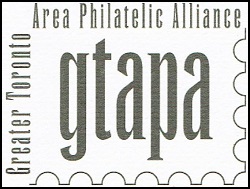
www.gtapa.org
The GTAPA is committed to promote and
stimulate the art of philately to all ages
for fun, culture, education and friendship.




